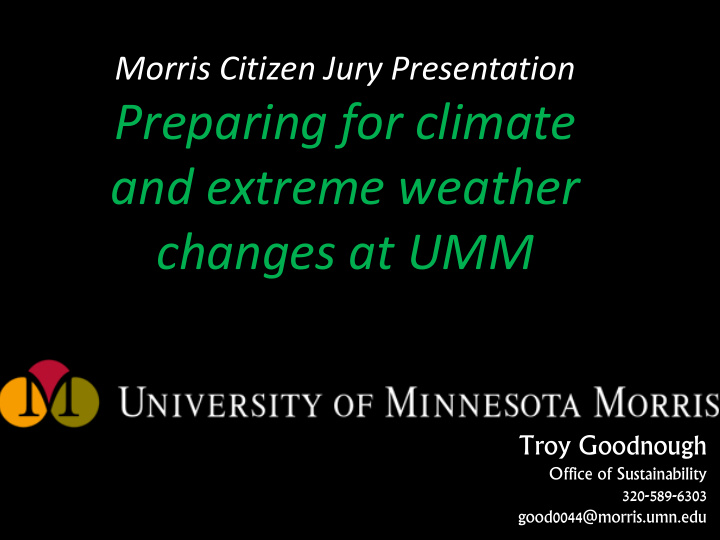



Morris Citizen Jury Presentation Preparing for climate and extreme weather changes at UMM Troy Goodnough Office of Sustainability 320-589-6303 good0044@morris.umn.edu
Concern #1: Extreme weather affects our campus energy supply Concern #2: Extreme weather affects our campus infrastructure. Concern #3: Extreme weather affects our campus landscape. Concern #4: Extreme weather is a by-product of a global warming
Concern #1: Extreme weather affects our campus energy supply Minnesota does not produce its own fossil fuel. We are dependent on other places to give us energy. Hotter/wetter summers require us to use more energy to do cooling. When it is really cold, our natural gas supply can be curtailed, we need to use large amounts of expensive (and dirtier) fuel oil. Colder winters require more energy to heat the campus.
Concern #2: Extreme weather affects our campus infrastructure The wind storms in the past year have added expenses to our campus operations. We have had to do more tree removal. Hail storms in the past two years have damaged buildings. Extreme rain events have damaged campus infrastructure.
$2M hail damage
Concern #3: Extreme weather affects our campus landscape. Long periods of drought affect our trees on campus, our campus yards, and our campus food gardens. Increased rain volumes mean we send more water, more quickly, to the Pomme de Terre river, instead of having more frequent lower volume rains which can be used more easily by plants and trees.
88 trees
http://www.dnr.state.mn.us/hydroclim/hc1406.html
Concern #4: Extreme weather is a by-product of a global warming. Burning carbon is leading to more extreme weather. We don't just want to adapt to it (which we will need to do). We also want to try to avoid making it even worse.
How is UMM responding to these concerns?
2007 – 2012 = 1,000,000 kWh energy reduction
STEVENS CO.
First Large-scale wind turbine at a public US university
60% of Morris’s electricity comes from wind
Twin turbines produce 10.5 million kWhrs per year
10,500,000 MkWh produced per year 8,500,000 MkWh used by campus per year ---------------------------------- 2,000,000 MkWh of “extra” energy produced by wind
Some estimations: 1,500 households in Morris 1,500 X 800 kWhr/month = 1.2MkWhr/month used in Morris 12 months/year X 1.2MkWhr/mo= 14MkWhr/year used by Morris
Morris Campus Turbine #2 U of M Debt (repaid by UMM) $3,600,000 UMM Utilities $310,372 UMM Internal Loan $64,028 Morris Campus 2009 HEAPR $420,000 Total: $4,395,000
70 percent of Morris’s heating and cooling needs
annually burns 9,000 tons of biomass
corn cobs
Natural Gas: Avg price: 5.704 dollars/MMcuft ( 40 % hedged) $/MMBTU 5.70 dollars Corn Cobs: Avg price: 87.87/dry ton ( Three year contract) $/MMBTU 5.78 dollars Wood Chips: Avg price: 101.08/ton $/MMBTU 6.35 dollars **2011/2012
32 flat-plate solar thermal panels
annually offsets 270 MMBtu of natural gas use
STUDENT ENERGY IS RENEWABLE AND SUSTAINABLE
POSSIBLE OPPORTUNITIES # 1: Become a renewable energy destination #2: Use extreme precipitation events to our advantage #3: Model construction practices that use less energy and can deal with hail/water events.
Recommend
More recommend